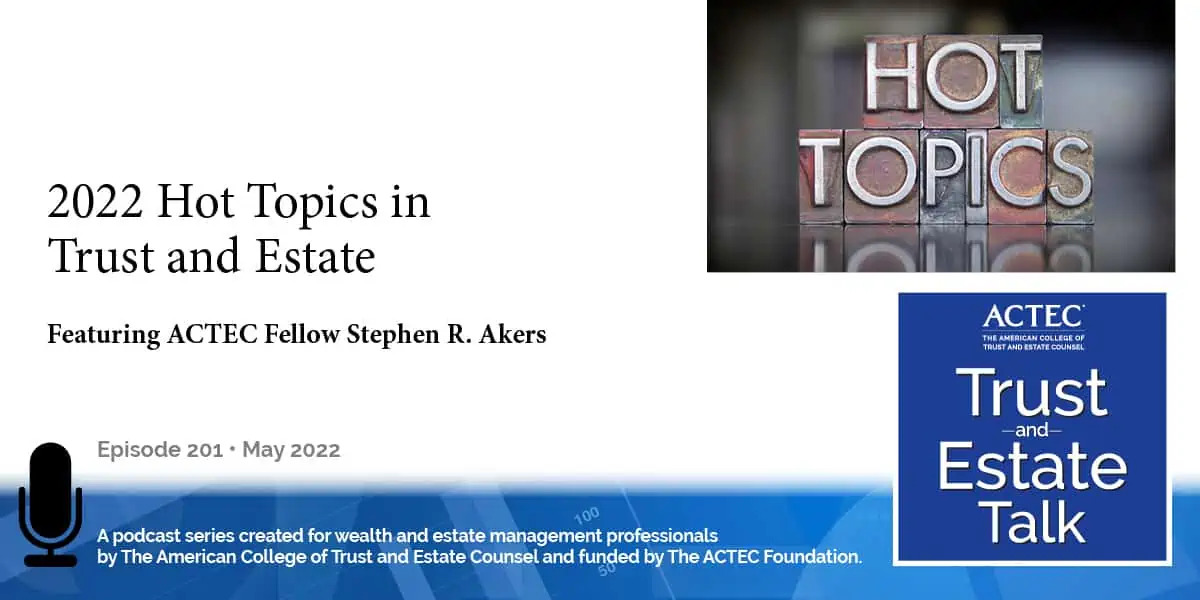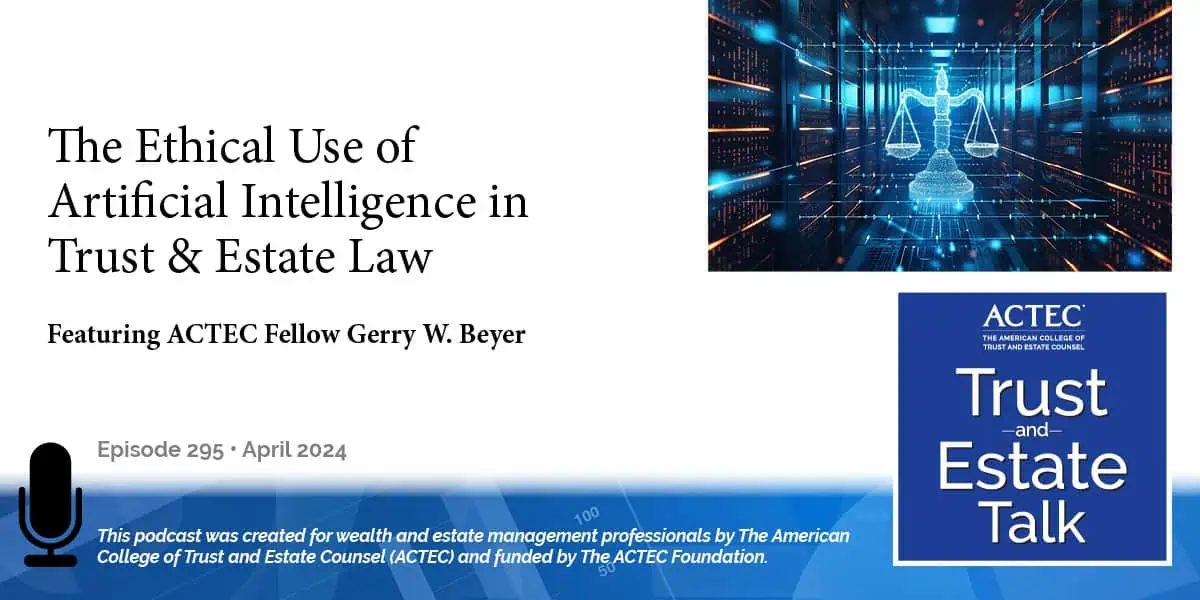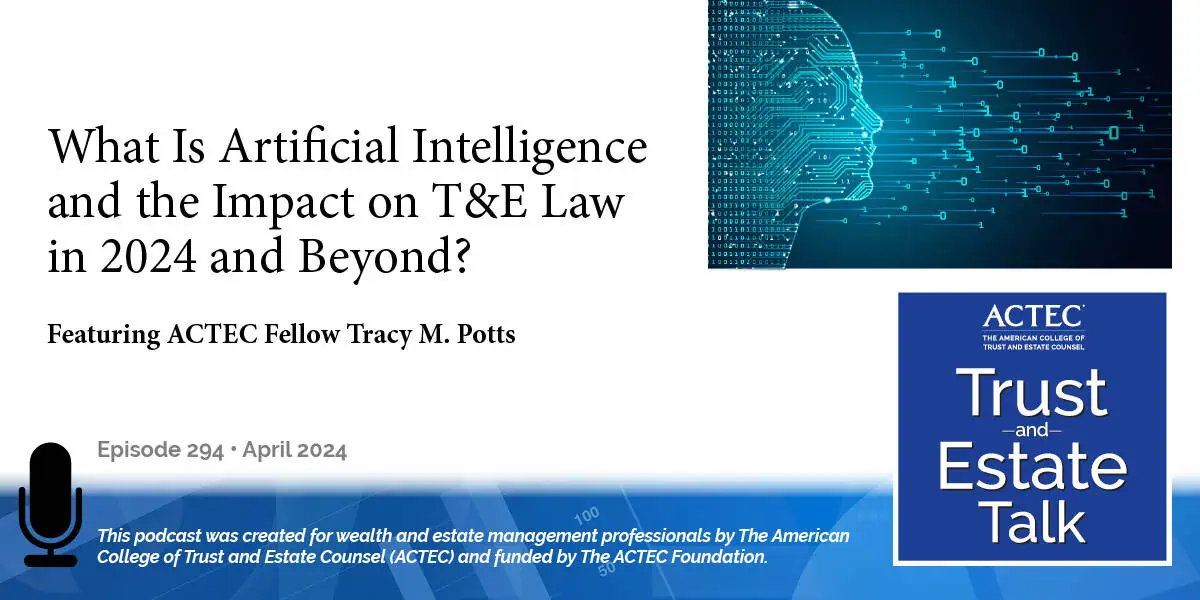2022 Hot Topics in Trust and Estate Law

“2022 Hot Topics in Trust and Estate Law,” that’s the subject of today’s ACTEC Trust and Estate Talk.
Transcript/Show Notes
This is Travis Hayes, ACTEC Fellow from Naples, Florida. ACTEC Fellow Steve Akers from Dallas, Texas is here today to fill us in on hot topics in trust and estate law, including the proposed regulations for the SECURE Act, the Estate of Levine v. Commissioner case, the Connolly v. United States case, and the Smaldino v. Commissioner case. Welcome, Steve.
SECURE Act Proposed Regulations
Thank you very much, Travis. The SECURE Act which we got in late 2019, generally, provides that amounts in qualified plans, or IRAs must be paid out within 10 years rather than being paid over the full life expectancy of the beneficiary. We received the proposed regulations on February 23rd of 2022, and I’m going to hit just some real highlights of those proposed regulations. The biggest surprise coming in the proposed regulation is that with the 10-year rule, there must be distributions made each year during that 10-year period of whatever amount would be made if there were a life expectancy payout.
We had thought, previously, by analogy to some other provisions, that no payments would be due until the very end of the 10-year period, but that’s not the position of the proposed regulations. Some good news coming out of the proposed regulations is that they really had some simplifying measures for accumulation trusts. There are two types of trusts for which we can look to the beneficiaries of the trust as the beneficiary of the plan to determine whether the plan has a “designated beneficiary” so that we don’t have to have all the benefits paid out within 5 years. And those two types are a conduit trust or an accumulation trust.
With the conduit trust, all amounts received from the plan are immediately paid out to the beneficiary. With an accumulation trust, whatever is received from the plan can be accumulated in the trust. Some of the measures that we got are simplifying for accumulation trusts; number one – we got some clarity on what successor beneficiaries of the trust do we have to count in determining whether or not all the beneficiaries are “designated beneficiaries” and, as well, who is the oldest of the beneficiaries.
We also got clarification about powers of appointment in that we don’t have to worry about permissible appointees under a power of appointment and whether or not they are designated beneficiaries – that is, individuals. But only when a power of appointment is exercised do we count whoever is the recipient under the power of appointment.
And we got similar rules for decanting or reformation of a trust, that after a decanting or reformation occurs, then we look at who is the recipient under the modification or the decanting. If that happens before September 30 of the year after the year of death, then that is deemed to be, we look at those as beneficiaries as of the date of death of the owner of the account. So, for accumulation trusts, we got some simplification measures.
Another simplifying matter: we can use accumulation trust for minors. There are five exceptions from the general rule that distributions have to be made within 10 years, one of those is for minors. The proposed regulation clarifies: this means for someone under age 21, we don’t have to look to different ages of majority in different states, and there’s no reference to completing a course of education. So, that’s a simplification. In addition, the proposed regulations clarified that we can use an accumulation trust for a minor, even if there are others who are also recipients, as long as the minor is the only current beneficiary that will still qualify for that exception. We can also use accumulation trusts for another of the exceptions, and that’s for disabled persons or chronically ill persons.
We also got clarification that we can have multiple beneficiaries of a trust, we can have multiple beneficiaries of conduit trusts or of accumulation trusts, where we had multiple beneficiaries and we generally would look to the oldest of the beneficiaries to determine the life expectancy payout during any period where we have a life expectancy payout. For some of those exceptions, there are different rules. For the minors, if we have multiple beneficiaries of an accumulation trust for minors, that is no longer qualifying for the minor exception when the oldest of those beneficiaries reaches age 21.
For disabled persons, on the other hand, if we had multiple disabled persons of a single trust, it is only when all of the disabled persons have died that the trust no longer ceases to be an “eligible designated beneficiary”. And then, last comment regarding the SECURE Act, is that for spouses, keep in mind that a standard QTIP trust will not qualify for the exception for spouses that is in the SECURE Act. It needs to be a QTIP trust in which we’ve added that all distributions from the plan will immediately be paid out to the spouse. Which means that it would be a combined conduit trust and a QTIP trust for the spouse.
Visit actec.org/secure-act for additional resources.
Estate of Levine v. Commissioner
I’m going to make some just very brief comments about the other cases. The Estate of Levine v. Commissioner, 158 Tax Court No. 2, is an intergenerational split-dollar life insurance case. A parent advanced bonds of $6,500,000 to a trust so that the trust could purchase life insurance on the life of the transferor’s daughter and the daughter’s husband. This was under a split-dollar arrangement so that the $6,500,000 would be repaid at the death of the insured, or, if the policies were turned in or the split-dollar agreement is terminated early.
The case is very interesting because it has a discussion, a very interesting discussion, of sections 2036 and 2038. The government argued that the entire $6,500,000 should be included in the gross estate. The estate argued that while the estate had the right to get back the $6,500,000 advance if the policy was kept until the insured died, that could be 20 years in the future and so, we ought to discount that back to present value. The government argued that because of sections 2036 and 2038, it ought to be the full $6,500,000.
A key fact in this case was that the decedent did not have the right to join with the trustee in the trust in deciding whether to turn the policy in early or to terminate the split-dollar agreement early. That is different than in the Cahill case and that factual difference was key to the 2036 and 2038 analysis. The court said that the decedent did not have the ability in conjunction with others – for example, the trustee of the trust- to decide to terminate the split-dollar agreement early, and therefore go ahead and get the $6,500,000 immediately. Well, even if they didn’t have the right under the exact split-dollar agreement, what about the fact that the parties to an agreement can always amend it?
And therefore, they could have got it back early. The court said looking to the old Supreme Court case, the Helmholtz case, that the mere ability to modify trusts under state law is not enough to trigger 2036 or 2038. That is helpful to us in planning limited partnerships or LLCs. We want to design those specifically not to say that if the decedent is a partner or a member that the decedent can join with others in dissolving the partnership or doing things that would be tax-sensitive measures.
Connolly v. United States
Connolly v. the U.S., 128 AFTR 2nd, 2021-5955. This is a district court case that discusses the buy-sell agreement. And it’s just interesting, there aren’t many cases discussing buy-sell agreements and whether or not they fix the estate tax value. This case did – it concluded that the agreement did not fix the estate tax value. It did not meet the section 2703 safe harbor. It did not meet the cases in the case law requirements for an agreement to set the estate tax value of the stock being purchased under the agreement. And so, therefore, the court had to value the stock at the decedent’s death. At issue, in this case, is that the corporation was going to buy back the stock, so the corporation had bought a life insurance policy on the decedent’s life.
The question was whether or not those life insurance death proceeds had to be taken into account in valuing the stock. The estate said no, the IRS said yes, and the court said yes, that it must be taken into consideration. And that was, despite the fact that the Blount case, an Eleventh Circuit case decided previously some years ago, had held the other way.
Smaldino v. Commissioner
The last case I’ll mention, the Smaldino case, is just very briefly to say always be aware of an indirect gift issue. If the husband makes a gift to the wife with the understanding that the wife will make a gift to the dynasty trust, then it is treated as if the husband made a gift to the dynasty trust.
In the Smaldino case, they tried to do that in order to use the wife’s gift exclusion amount – it didn’t work. And, indeed, there were terrible facts in that case – the wife had agreed expressly that she would turn around and give those assets into the dynasty trust. That could be just really devastating if we’re not talking about a trust for children, but we’re talking about what we commonly call a Spousal Lifetime Access Trust, a SLAT. If we want to create a trust in which the wife is a discretionary beneficiary, but the husband creates the trust, the husband is not a beneficiary so it’s not in the husband’s estate under 2036. It’s not in the wife’s estate because she’s not the creator of the trust. But, if the wife was the moneyed spouse and the wife gave assets to the husband with the understanding that the husband would turn around and give them into the SLAT, this result of the Smaldino case would be there. So, be sensitive to that possibility. Those are a few of the current developments and hot topics important for 2022.
Thank you, Steve, for updating us on 2022 hot topics and trust and estate law.
You may also be interested in:
- The SECURE Act and Retirement Account Planning Opportunities
- ACTEC’s Secure Act resource webpage org/secure-act
- Utilization of Section 7872
- Understanding Serious Mistakes and Planning Implications in the Smaldino Tax Court Case
- Top Estate Planning and Estate Tax Developments of 2021
This podcast was produced by The American College of Trust and Estate Counsel, ACTEC. Listeners, including professionals, should under no circumstances rely upon this information as a substitute for their own research or for obtaining specific legal or tax advice from their own counsel. The material in this podcast is for information purposes only and is not intended to and should not be treated as legal advice or tax advice. The views expressed are those of speakers as of the date noted and not necessarily those of ACTEC or any speaker’s employer or firm. The information, opinions, and recommendations presented in this Podcast are for general information only and any reliance on the information provided in this Podcast is done at your own risk. The entire contents and design of this Podcast, are the property of ACTEC, or used by ACTEC with permission, and are protected under U.S. and international copyright and trademark laws. Except as otherwise provided herein, users of this Podcast may save and use information contained in the Podcast only for personal or other non-commercial, educational purposes. No other use, including, without limitation, reproduction, retransmission or editing, of this Podcast may be made without the prior written permission of The American College of Trust and Estate Counsel.
If you have ideas for a future ACTEC Trust & Estate Talk topic, please contact us at ACTECpodcast@ACTEC.org.
© 2018 – 2024 The American College of Trust and Estate Counsel. All rights reserved.
Latest ACTEC Trust and Estate Talk Podcasts

The Ethical Use of Artificial Intelligence in Trust & Estate Law
A law professor offers insights into the risks, rewards, duties and ethical considerations of lawyers using AI in their T&E practices.

What Is Artificial Intelligence and the Impact on T&E Law in 2024 and Beyond?
A primer on the types and uses of AI, then a deeper dive into the impact on trust and estate law from types to applications to ethical considerations.

The IRS Ruling on Modifying a Grantor Trust
Explore the gift tax implications for trust beneficiaries modifying grantor trusts in IRS CCA 202352018, with nuanced analysis and estate planning insights.

